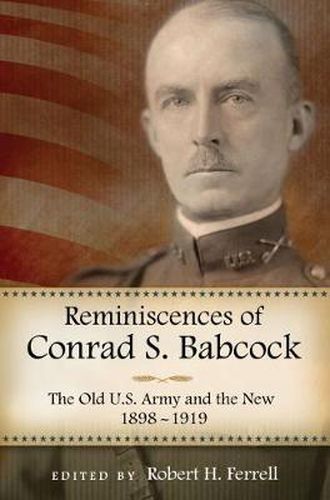Reminiscences of Conrad S. Babcock: The Old U.S. Army and the New, 1898-1918

Reminiscences of Conrad S. Babcock: The Old U.S. Army and the New, 1898-1918
The son of an army officer, Conrad S. Babcock graduated from West Point in 1898, just in time for the opening of the Spanish-American War. Because of his father’s position, he managed to secure a place in the force that Major General Wesley Merritt led to Manila to secure the city. The Philippine Insurrection, as Americans described it, began shortly after he arrived. What Babcock observed in subsequent months and years, and details in his memoir, was the remarkable transition the U.S. Army was undergoing. From after the Civil War until just before the Spanish War, the army amounted to 28,000 men. It increased to 125,000, tiny compared with those of the great European nations of France and Germany, but the great change in the army came after its arrival in France in the summer of 1918, when the German army compelled the U.S. to change its nineteenth-century tactics. Babcock’s original manuscript has been shortened by Robert H. Ferrell into eight chapters which illustrate the tremendous shift in warfare in the years surrounding the turn of the century. The first part of the book describes small actions against Filipinos and such assignments as taking a cavalry troop into the fire-destroyed city of San Francisco in 1906 or duty in the vicinity of Yuma in Arizona when border troubles were heating up with brigands and regular troops. The remaining chapters, beginning in 1918, set out the battles of Soissons (July 18-22) and Saint-Mihiel (September 12-16) and especially the immense battle of the Meuse-Argonne (September 26-November 11), the largest (1.2 million troops involved) and deadliest (26,000 men killed) battle in all of American history. By the end of his career, Babcock was an adroit battle commander and an astute observer of military operations. Unlike most other officers around him, he showed an ability and willingness to adapt infantry tactics in the face of recently developed technology and weaponry such as the machine gun. When he retired in 1937 and began to write his memoirs, another world war had begun, giving additional context to his observations about the army and combat over the preceding forty years. Until now, Babcock’s account has only been available in the archives of the Hoover Institution, but with the help of Ferrell’s crisp, expert editing, this record of army culture in the first decades of the twentieth century can now reach a new generation of scholars.
This item is not currently in-stock. It can be ordered online and is expected to ship in approx 4 weeks
Our stock data is updated periodically, and availability may change throughout the day for in-demand items. Please call the relevant shop for the most current stock information. Prices are subject to change without notice.
Sign in or become a Readings Member to add this title to a wishlist.


